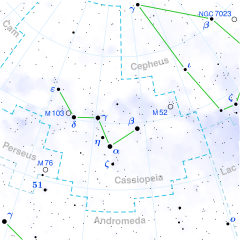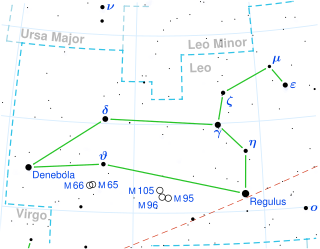
R Leonis is a red giant Mira-type variable star located approximately 370 light years away in the constellation Leo.

4 Cassiopeiae is a red giant in the northern constellation of Cassiopeia, located approximately 790 light-years away from the Sun. It is visible to the naked eye as a faint, red-hued star with a baseline apparent visual magnitude of 4.96. At the distance of this system, its visual magnitude is diminished by an extinction of 0.56 due to interstellar dust. This system is moving closer to the Earth with a heliocentric radial velocity of −39 km/s.
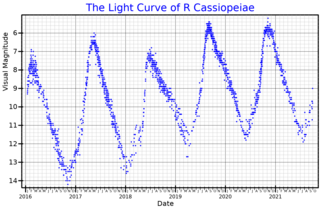
R Cassiopeiae is a variable star in the northern constellation of Cassiopeia. It is located approximately 574 light years distant from the Sun, but is drifting closer with a radial velocity of −23 km/s. This is a pulsating Mira-type variable star with a brightness varies from magnitude +4.4 down to +13.5 with a period of 433.6 days. At its maximum, R Cassiopeiae is visible to the naked eye as a faint, red-hued star.

R Centauri is a Mira variable star in the constellation Centaurus.

R Andromedae is a Mira-type variable star in the constellation Andromeda. Its spectral class is type S because it shows absorption bands of zirconium monoxide (ZrO) in its spectrum. It was among the stars found by Paul Merrill to show absorption lines of the unstable element technetium, establishing that nucleosynthesis must be occurring in stars. The SH molecule was found for the first time outside earth in the atmosphere of this star. The star is losing mass due to stellar winds at a rate of 1.09×10−6M☉/yr.

V Aquilae is a carbon star and semiregular variable star in the constellation Aquila. It has an apparent magnitude which varies between 6.6 and 8.4 and is located around 400 parsecs (1,300 ly) away.
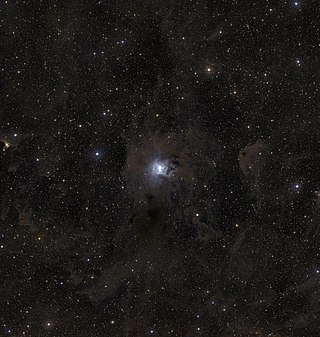
T Cephei is a Mira variable star in the constellation Cepheus. Located approximately 600 light-years distant, it varies between magnitudes 5.2 and 11.3 over a period of around 388 days.

NO Aurigae is a pulsating variable star in the constellation Auriga. It is an unusually-luminous asymptotic giant branch star about 3,500 light years away.
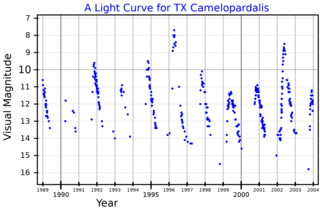
TX Camelopardalis is a Mira-type variable star in the constellation Camelopardalis. It is a classical long period variable star with pulsational period of 558.7 days. Water masers have been observed around the star.
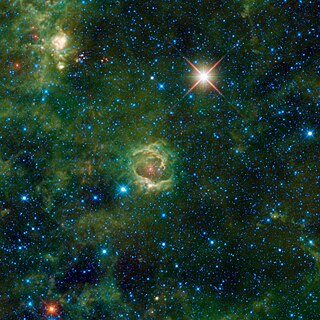
PZ Cassiopeiae is a red supergiant star located in the constellation of Cassiopeia, and a semi-regular variable star.

Y Centauri or Y Cen is a semiregular variable star in the constellation of Centaurus.

R Geminorum is a Mira variable and technetium star in the constellation Gemini. It is located approximately 850 parsecs (2,800 ly) away.

W Aquilae is a variable star in the constellation of Aquila. It is a type of evolved star known as an S-type star. Due to its relatively close distance of 1,200 light-years and equatorial location, it is easy to observe and heavily studied.

IK Tauri or NML Tauri is a Mira variable star located about 280 parsecs (910 ly) from the Sun in the zodiac constellation of Taurus.

II Lupi is a Mira variable and carbon star located in the constellation Lupus. It is the brightest carbon star in the southern hemisphere at 12 μm.

T Leporis is a variable star in the constellation of Lepus, the Hare. It is located half a degree from ε Leporis in the sky; its distance is approximately 1,100 light years from the Solar System. It has the spectral type M6ev, and is a Mira variable — as is R Leporis, in the same constellation — whose apparent magnitude varies between +7.40 and +14.30 with a period of 368.13 days.
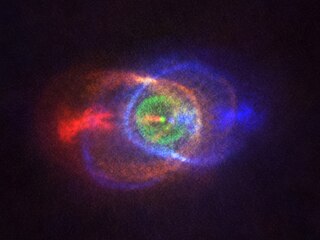
HD 101584 is a suspected post-common envelope binary about 1,800 to 5,900 light-years distant in the constellation of Centaurus. The system is bright at optical wavelengths with an apparent visual magnitude of about 7. The primary is either a post-AGB star, but more likely a post-RGB star. The secondary is a red dwarf or possibly a low-luminosity white dwarf, which orbits the primary every 150-200 days. The system is surrounded by a slowly rotating circumbinary disk, probably with a face-on orientation towards the solar system and a size of about 150 astronomical units.
V669 Cassiopeiae or V669 Cas is an OH/IR star, a type of particularly cool red giant, with a spectral type of M9III.

RT Virginis is a variable star in the equatorial constellation of Virgo, abbreviated RT Vir. It ranges in brightness from an apparent visual magnitude of 7.7 down to 9.7, which is too faint to be visible to the naked eye. Based on parallax measurements made with the VLBI, the distance to this star is approximately 740 light years. It is receding from the Sun with a radial velocity of 17 km/s.
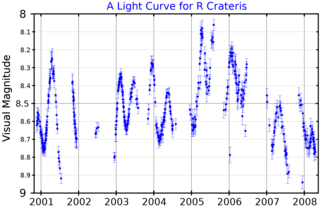
R Crateris is a star about 700 light years from the Earth in the constellation Crater. It is a semiregular variable star, ranging in brightness from magnitude 8.1 to 9.5 over a period of about 160 days. It is not visible to the naked-eye, but can be seen with a small telescope, or binoculars. R Crateris is a double star; the variable star and its magnitude 9.9 F8V companion are separated by 65.4 arcseconds.
